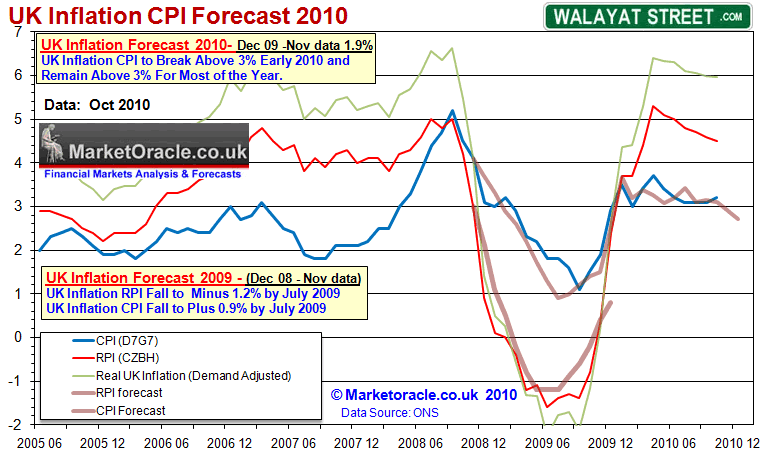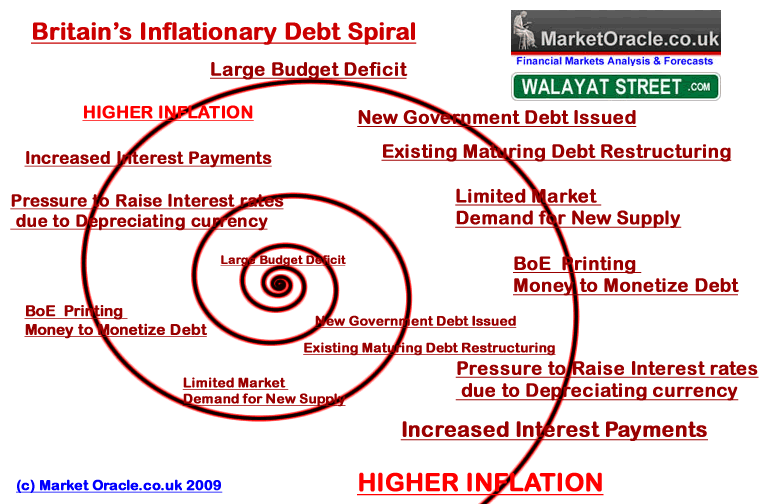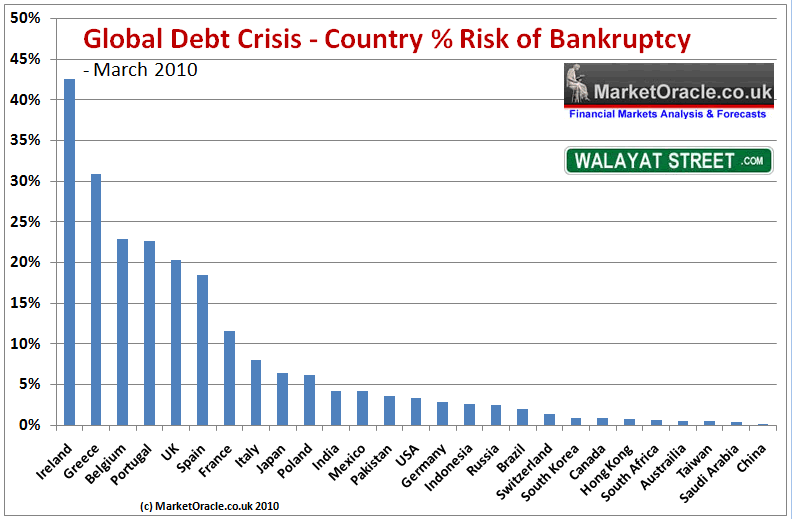Results 1 to 1 of 1
Thread Information
Users Browsing this Thread
There are currently 1 users browsing this thread. (0 members and 1 guests)
-
11-26-2010, 07:22 PM #1Senior Member


- Join Date
- May 2007
- Location
- South West Florida (Behind friendly lines but still in Occupied Territory)
- Posts
- 117,696
Euro Debt Crisis Protect Savings/Deposits Banks Going Bankru
Euro Debt Crisis Bankruptcy Bailout Queue, Protect Savings & Deposits From Banks Going Bankrupt!
Personal_Finance / Credit Crisis 2010
Nov 26, 2010 - 01:14 AM
By: Nadeem_Walayat
The global banking system that publicly went bankrupt during September 2008 prompting government interventions in the form of capital injections, buying of toxic assets, insurance of bad debts and even outright nationalisation's has started to bankrupt the states that bailed them out, starting with the smaller states with Iceland setting the ball rolling, and this year the bailiffs came knocking on the doors of the Eurozone club members, with first Greece, and now Ireland requiring a Euro-zone bailout (German) to prevent debt default bankruptcy, where if one falls then soon would all of the dominos tumble.
The Euro 200 billion bailout out of Greece and Ireland is in the form of a series of loans set at a 5% interest rate, against which one can measure the relative credit risks in the market as theoretically 5% should be seen as a cap with the view that market rates should be below the 5% bailout rate. However the bond markets are NOT responding positively to Ireland's bailout as they had done during May's Greece bailout, which is evidenced by the yields on 10 year euro-zone sovereign bonds rising across the board:
Greece's 10 year yield continues to trade at a high 12% despite the Euro 110 billion bailout at 5%, because Greek bond holders continue to discount a highly probable eventual debt default / restructuring as a deflating economy has sent public debt to GDP soaring to 135%.
Ireland's yield has surged higher to stand at 9.2%, following Monday's bailout low of 8%, again suggesting debt restructuring given depression inducing public debt at 95% of GDP.
Portugal's yield has crept higher to a new credit crisis high of 7.1% from Mondays low of 6.7%, confirming that a bailout of Portugal at an estimated Euro 40-80 billion is imminent for an uncompetitive economy carrying a rising debt to GDP ratio at 83%.
Spain's yield has now crossed above the 5% bailout rate to 5.2%, which suggests that the market is pricing in a bailout for Spain, which is not surprising given the exposure of Spanish banks to Portuguese debts, official debt is put at 64% of GDP but this does not fully take into accounts Spanish banks bad debts that as with Ireland could easily send Spain's debt to GDP to well over 100%.
Italy's yield has trended higher to 4.42% putting Italy firmly in the queue for a debt crisis blowout given that public debt is already at 120% of GDP.
Belgium's yield rose to 3.7%, which illustrates an elevated risk as a consequence of the failure of the political parties to form a new government and public debt is already at 100% of GDP.
UK - Whilst not part of the eurozone has seen its 10 year yields continue to trend higher to 3.3%, marginally below the recent high of 3.4%. The lower UK yield despite Britains huge debt mountain illustrates the flexibility afforded by being OUTSIDE the euro-zone as it allows Britain to continue to stealth default on its debts by means of printing money induced high inflation that the Eurozone countries cannot do individually I.e. the UK government prints money that it loans to the bankrupt banks at 0.5% to buy UK government bonds at 3.3%, hence why the yields are lower than the likes of Spain and Italy, which acts as a safety valve preventing outright bankruptcy but the price paid is in high inflation, with the doctored official inflation measure of CPI is at 3.2%, the more recognised RPI at 4.5% and real inflation at 6% as the following graph illustrates.

The CPI inflation trend is inline with forecast expectations as of December 2009 (27th December 2009 (UK CPI Inflation Forecast 2010, Imminent and Sustained Spike Above 3%) http://www.marketoracle.co.uk/Article16085.html
France's yield at 3.14 illustrates that France still retains some room for manoeuvre despite being in the Euro-zone.
Germany, the primary funder of the Euro-zone bailouts and also the benchmark for where the Euro-zone debt collectively used to trade, saw its 10 year bund yields rise a little to 2.7%.
The Debt Interest Spiral
Virtually all countries continue to run huge budget deficits well above the 3% limit / targets that ensure the total debts will continue to grow which means if the economies fail to grow GDP faster then they accumulate debt, then Debt as a percentage of GDP will grow even faster thus triggering an out of control debt interest spiral as warned off in December 2009 (03 Dec 2009 - Britain's Inflationary Debt Spiral as Bank of England Keeps Expanding Quantitative Easing ). http://www.marketoracle.co.uk/Article15521.html

The problem for the bankrupting PIIGS remains is that they cannot inflate their way out of debt, therefore economic austerity resulting in contracting economies means an ever higher debt burden which means that ALL of the bailed out countries will require further bailouts down the road as their debt mountains continue to grow. Thus ultimately the bailouts are just delaying the inevitable debt defaults / restructuring.
Again I have to reiterate - DEBT DEFAULT IS INEVITABLE, with Greece and Ireland now at the top of the Debt Default List. With the first in the queue to experience default being bond investors that have loaned monies to the bankrupt banks. Clearly the Euro-zone is attempting to delay inevitable debt default until the Euro-zone financial system has repaired itself enough to withstand a Greece and Ireland default.
The Euro-Zone Bankruptcy Queue
My original analysis of the countries at the highest risk of going bankrupt of March and April 2010 (13 Apr 2010 - Britain's Accelerating Trend Towards High Inflation and UK Debt Default Bankruptcy ) http://www.marketoracle.co.uk/Article18622.html warned that a far bigger problem was brewing in Ireland that would blow up over the coming months during which period the mainstream press has been focused on Greece. If it were not for the E.U. bailout than Ireland and Greece would have gone the way of Iceland i.e. bankrupt.

However as the graph illustrates the risk of bankruptcy does not stop with Ireland and Greece, as whilst the mainstream press has finally woken up to Portugal being next, however they still are asleep to the third country on my list of countries most likely to go bankrupt, requiring a bailout namely Belgium, which in fact at the time I rated as being a head of Portugal.
The current state of the trends towards bankruptcy taking the earlier bond yields analysis into account suggests that the situation for Portugal, Spain and Italy has deteriorated since my original analysis of March 2010, and improved for the UK and to a lesser extent for Belgium, therefore I would now rank the bankruptcy order as :
Greece - Bust requiring bailed Euro 110 bailout
Ireland - Bust requiring Euro 85 billion Bailed out
Portugal - Pending an imminent bailout of approx Euro 40-80 billion
Belgium - Pending bailout of approx Euro 50 billion.
Spain - Pending bailout of approx Euro 400 to 500 billion.
Italy - Pending bailout approx Euro 1 trillion+.
According to May's bailout of Greece, the total funds made available to bailout the Euro-zone members was put at Euro 750 billion. Therefore after Portugal, there would just not be enough to bailout Spain that could reach as high as Euro 500 billion, which is why the Chancellor Angela Merkel made the statement on Nov 25th, warning bond investors that they should prepare themselves for a haircut as debt is restructured (partial default).
âDo politicians have the courage to place the risk burden on those who make money? Or is trading in sovereign debt the only business in the world in which there is no need to take risk?âJoin our efforts to Secure America's Borders and End Illegal Immigration by Joining ALIPAC's E-Mail Alerts network (CLICK HERE)


 LinkBack URL
LinkBack URL About LinkBacks
About LinkBacks




 Reply With Quote
Reply With Quote

Former U.K. immigration minister: Migrants do more harm than...
05-02-2024, 12:14 AM in General Discussion